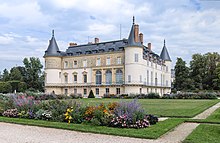1st G6 summit
| 1st G6 summit | |
|---|---|
 Château de Rambouillet | |
| Host country | France |
| Dates | 15–17 November 1975 |
| Precedes | 2nd G7 summit |
The 1st G6 summit took place on 15–17 November 1975, in Rambouillet, France. The venue for the summit meetings was the Château de Rambouillet near Paris.[1]
The Group of Six (G6) was an unofficial forum which brought together the heads of the richest industrialized countries: France, West Germany, Italy, Japan, the United Kingdom, and the United States.[2] This summit, and the others which would follow, were not meant to be linked formally with wider international institutions; and in fact, a kind of frustrated rebellion against the stiff formality of other international meetings was an element in the genesis of cooperation between France's president and West Germany's chancellor as they conceived the first summit of the G6.[3]
Later summits in what could become a continuing series of annual meetings were identified as the Group of Seven (G7) and Group of Eight (G8) summits — but this informal gathering was the one which set that process in motion.
Leaders at the summit
This was an unofficial forum (retreat) for the leaders of France, Germany, Italy, Japan, the United Kingdom, and the United States, and a chance for them to get to know one another. It was important to note that each of them had attained office the previous year due to unforeseeable circumstances.
Participants

These summit participants considered themselves representative of the "core" industrialized countries forum:[4][1]
| Core G6 members Host state and leader are shown in bold text. | ||||
| Member | Represented by | Title | achieved office | |
|---|---|---|---|---|
| France | Valéry Giscard d'Estaing | President | May 1974 | |
| West Germany | Helmut Schmidt | Chancellor | May 1974 | |
| Italy | Aldo Moro | Prime Minister | November 1974 | |
| Japan | Takeo Miki | Prime Minister | December 1974 | |
| United Kingdom | Harold Wilson | Prime Minister | March 1974 | |
| United States | Gerald Ford | President | August 1974 | |
Issues

The summit was intended as a venue for resolving differences among its members. As a practical matter, the summit was also conceived as an opportunity for its members to give each other mutual encouragement in the face of difficult economic decisions.[3] Rambouillet had no easy answers to what was then the most serious recession since the 1930s; but the main themes of what would later become known as the "1st G7/G8 summit" will remain for decades on the world's agenda—avoiding protectionism, energy dependency and boosting growth.[5][6]
Issues which were discussed at this summit included:
- Searching and productive exchange of views on world economy
- Political and economic responsibilities of democracies
- Growth of interdependence and fostering international cooperation
- Inflation and energy crises
- Unemployment and economic recovery
- Fostering growth of world trade
- Monetary stability
- Multilateral trade negotiations
- Economic relations with the Soviet Union and the Eastern Bloc
- Cooperative relationship and improved understanding of developing countries
- Conference on International Economic Co-operation
- Cooperation via international organizations
Gallery
Notes
- ^ a b Japan, Ministry of Foreign Affairs (MOFA): Summit Meetings in the Past.
- ^ Saunders, Doug. "Weight of the world too heavy for G8 shoulders," Globe and Mail (Toronto). 5 July 2008 – n.b., the G6 becomes the Group of Seven (G7) with the addition of Canada starting in 1976; and the G7 becomes the Group of Eight (G8) with the inclusion of Russia starting in 1997, reverting to the Group of Seven (G7) after the suspension of Russia in 2014.
- ^ a b Reinalda, Bob and Bertjan Verbeek. (1998). Autonomous Policy Making by International Organizations, p. 205.
- ^ Rieffel, Lex. "Regional Voices in Global Governance: Looking to 2010 (Part IV)," Archived 3 June 2010 at the Wayback Machine Brookings. 27 March 2009; "core" members (Muskoka 2010 G-8, official site). Archived 2 June 2010 at the Wayback Machine
- ^ Stewart, Heather and Larry Elliott. "Hopes fading for salvation at the summit," The Guardian (London). 22 March 2009.
- ^ "Big Six optimistic after currency pact". Glasgow Herald. 18 November 1975. p. 2. Retrieved 18 June 2013.
References
- Bayne, Nicholas and Robert D. Putnam. (2000). Hanging in There: The G7 and G8 Summit in Maturity and Renewal. Aldershot, Hampshire, England: Ashgate Publishing. ISBN 978-0-7546-1185-1; OCLC 43186692 (Archived 2009-05-13)
- Reinalda, Bob and Bertjan Verbeek. (1998). Autonomous Policy Making by International Organizations. London: Routledge. ISBN 978-0-415-16486-3; ISBN 978-0-203-45085-7; OCLC 39013643
External links
- No official website is created for any G6/G7 summit prior to 1995 – see the 21st G7 summit.
- "G6 1975, delegations & documents". University of Toronto: G7 Research Group. Retrieved 17 December 2020.






